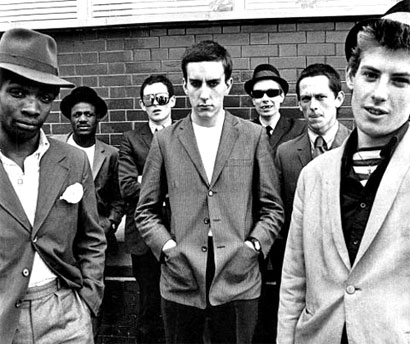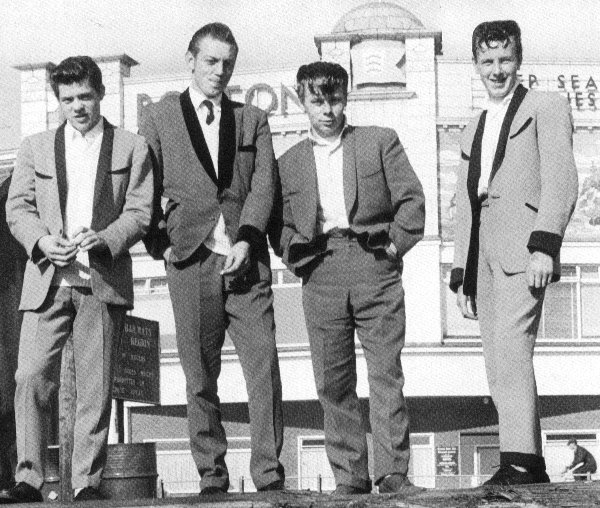 Rude boys were associated with the poorer sections of Kingston, where ska and rocksteady were the popular form of music. They dressed in the latest fashions at dancehalls and on the streets. Many of these rudies started wearing sharp suits, thin ties, and pork pie or Trilby hats; inspired by United States gangster movies, jazz musicians and soul music artists. As the Jamaican diaspora grew in the United Kingdom during the 1960s, Jamaican youth or "rude boy"music and fashion became a strong influence on British subcultures.
Rude boys were associated with the poorer sections of Kingston, where ska and rocksteady were the popular form of music. They dressed in the latest fashions at dancehalls and on the streets. Many of these rudies started wearing sharp suits, thin ties, and pork pie or Trilby hats; inspired by United States gangster movies, jazz musicians and soul music artists. As the Jamaican diaspora grew in the United Kingdom during the 1960s, Jamaican youth or "rude boy"music and fashion became a strong influence on British subcultures. The British Teddy boy subculture is typified by young men wearing clothes inspired by the styles of the Edwardian period, which Savile Row tailors had tried to re-introduce after World War II. The group got its name after a 1953 newspaper headline shortened Edward to Teddy and coined the term Teddy Boy. The subculture started in London in the 1950s and rapidly spread across the UK; soon becoming strongly associated with American rock and roll music of the period. The Teddy Boys were the first youth group in England to differentiate themselves as teenagers, thus helping to create a youth market. The Teds morphed into the Rockers in the 1960's.
The British Teddy boy subculture is typified by young men wearing clothes inspired by the styles of the Edwardian period, which Savile Row tailors had tried to re-introduce after World War II. The group got its name after a 1953 newspaper headline shortened Edward to Teddy and coined the term Teddy Boy. The subculture started in London in the 1950s and rapidly spread across the UK; soon becoming strongly associated with American rock and roll music of the period. The Teddy Boys were the first youth group in England to differentiate themselves as teenagers, thus helping to create a youth market. The Teds morphed into the Rockers in the 1960's. Mod, a term which may have been coined by Pete Meaden when he was famously quoted as saying "Modism, mod living, is an aphorism for clean living under difficult circumstances". There are contradicting stories about the origins of the first mods, but one popular belief is that the movement began with a few disparate cliques of middle class teenage boys with family connections to the garment trade in London in 1958. These early mods were obsessed with new fashions such as slim-cut Italian suits, and music styles such as modern jazz and rhythm and blues. And one can't forget the scooters, an essential part of the Mod wardrobe.
Mod, a term which may have been coined by Pete Meaden when he was famously quoted as saying "Modism, mod living, is an aphorism for clean living under difficult circumstances". There are contradicting stories about the origins of the first mods, but one popular belief is that the movement began with a few disparate cliques of middle class teenage boys with family connections to the garment trade in London in 1958. These early mods were obsessed with new fashions such as slim-cut Italian suits, and music styles such as modern jazz and rhythm and blues. And one can't forget the scooters, an essential part of the Mod wardrobe.Rockers, wearing leather jackets and riding heavy motorcycles, poured scorn on the mods, who wore suits and rode scooters. The rockers considered mods to be weedy, effeminate snobs. Mods saw rockers as out of touch, oafish and grubby. Mods were usually city dwellers, whereas rockers tended to be more rural. Mods sometimes held down office jobs, whereas rockers were often manual workers (although there were many exceptions in both groups). Musically, there was not much common ground; with the rockers clinging to 1950s rock and roll, mostly by white American artists such as Elvis Presley, Gene Vincent and Eddie Cochran. Mods generally favoured 1960s rhythm and blues, soul and ska by black American and Jamaican musicians. Conflict came to a head at the Second Battle of Hastings, Brighton, 1964.
 Around 1965, a schism developed between the peacock mods (also known as smooth mods), who were less violent and always wore the latest expensive clothes, and the hard mods (also known as gang mods), who were identified by their shorter hair and more working-class image. Early followers were mainly interested in and influenced by Jamaican Reggae and Ska music (aka, The Spirit of 69), Jamaican Rude Boy culture and a dislike of those perceived as the 'ruling classes'. They had an extreme dislike for the government and many larger businesses as both appeared to lack sympathy for the increasingly desperate straits of the working class. See The Who and The Kinks(above).
Around 1965, a schism developed between the peacock mods (also known as smooth mods), who were less violent and always wore the latest expensive clothes, and the hard mods (also known as gang mods), who were identified by their shorter hair and more working-class image. Early followers were mainly interested in and influenced by Jamaican Reggae and Ska music (aka, The Spirit of 69), Jamaican Rude Boy culture and a dislike of those perceived as the 'ruling classes'. They had an extreme dislike for the government and many larger businesses as both appeared to lack sympathy for the increasingly desperate straits of the working class. See The Who and The Kinks(above).
No comments:
Post a Comment